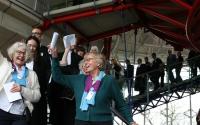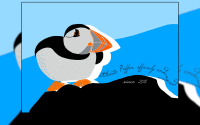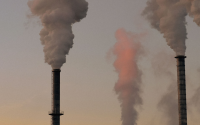7 December 2004David Shukman
 The floating front of Pine Island is offering less resistance to the mass of ice behind |
A number of glaciers have been observed to be advancing into the ocean at eight times the rate they were a decade ago.
Much of the data for this research is gathered by a series of low-level flights by aircraft fitted with special equipment.
It chills the blood to hear the phrase, "if we have to crash-land on the ice". But those were the opening words of our pre-flight briefing.
The interior of the plane that would take us to Antarctica and back - a 12-hour round trip - was crammed with emergency provisions: survival suits, tents, and food for 4-5 days.
I found it curiously heartening to note that the planners had had the good taste to include one litre of extra virgin olive oil, a packet of oregano and a big box of tea-bags.
Ice hunter
Our starting point for the long haul was the southernmost city in the world, Punta Arenas in Chile. The plane was an Orion P-3 maritime surveillance aircraft operated by the Chilean Navy.
 |
I tried to keep out of the way as the crew got ready. There was an urgency about their preparations.
The latest weather forecast had indicated a clear patch in the skies above one part of western Antarctica, the Pine Island glacier, and in this part of the world the weather is everything.
The project leaders had just decided to bank on the forecast being accurate and gave a "go" for launch. Soon I was peering through a window at the jagged coastline of Tierra del Fuego, our last sight of land before the Southern Ocean.
 A laser measures ice elevation to an accuracy of centimetres |
Even so, just getting to the target area took us five noisy hours. The scientists on board ceaselessly checked their instruments. It is a long way to go for a malfunction.
The radar that would measure the thickness of the ice was performing well. But the operator of the laser that would measure the elevation of the ice had to crawl into the belly of the plane to make sure it was working by the time it was needed.
Warming peninsular
We felt the plane descend to a low level. The readings need to be taken at an altitude of about 300m (1,000ft). The crucial data was coming in thick and fast. But this was not a comfortable ride. The strong winds and turbulence rocked the plane and steep turns did not help.
The views, though, were extraordinary. From the cockpit window I could see the ice sheet stretching away in the crystal-clear air. Huge swathes of dark crevasses marked the path of the glacier.
 Nasa scientist Bob Thomas (l) wants to know if the thinning is accelerating |
A shout of amazement brought us to a window in the side. We had reached the ice-front where icebergs the size of office blocks were breaking into a dark blue sea.
The fissures between the cliffs were on the scale of Manhattan streets.
We were following a track first pioneered by the same team two years before. The data from this flight will be compared with the earlier results.
There is every expectation that it will reveal what the scientists have found in some other parts of Antarctica: that the ice is in retreat.
Data flow
Previous missions have found that when the floating ice shelves break up, the landed glaciers feeding them accelerate, sometimes dramatically. This has already been observed on the Antarctic Peninsula, one of the three fastest warming regions on Earth.
The mission I joined will help reveal the extent to which this process is also happening further south, along the stretch of coast known as Pine Island.
 On this type of mission, it is essential to prepare for the worst |
"The ice has to go somewhere and it goes into the sea, raising sea levels," he told me. "We want to increase the precision with which we measure thinning rates and we want to know if the thinning is accelerating.
"If the thinning remains so that we only get a sea-level rise of about 2mm a year, this probably isn't a problem. But if it is accelerating, we can start to measure how serious a problem this might be in the future."
After an hour-and-a-half at low level the flight crew warned that it was time for the journey home. There were still five hours of flying ahead of us and, faced with the risk of strong headwinds, the priority was to conserve fuel.
As we rose to our cruising altitude, there was a wave of relief throughout the plane. The gamble with the weather had paid off. The flow of data had been excellent. And a late lunch of steak and mashed potato went down well.
We approached Chile in total darkness. But then the clouds parted, and from behind the pilot's seat, I saw an unbelievably welcome sight: a tiny cluster of lights, the first sign of human habitation all day.
It occurred to me that the phrase "climate change" is easily bandied about it; far harder gathering the facts that explain what it really means - even if the olive oil, oregano and tea bags had not been needed.






